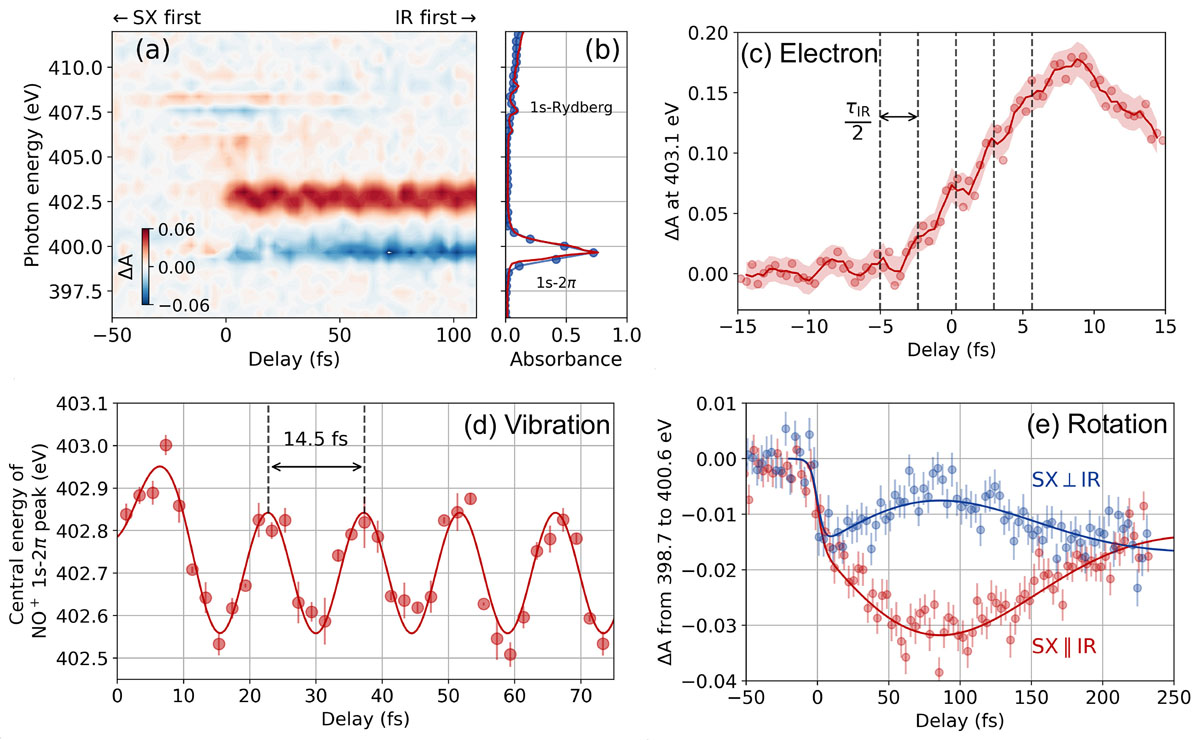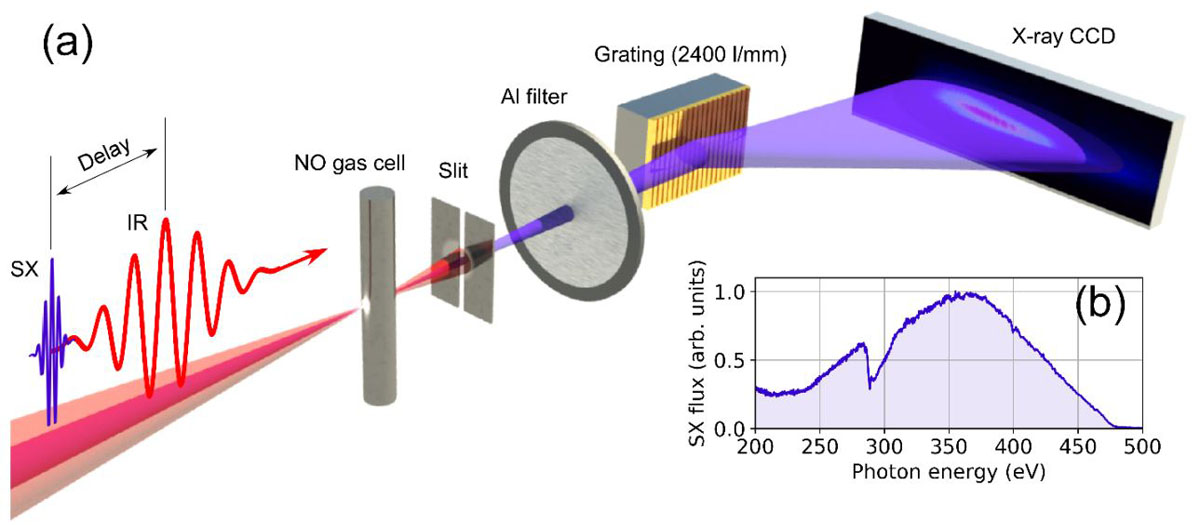Real-Time Observation of Electronic, Vibrational, and Rotational Dynamics in Nitric Oxide with Attosecond Soft X-Ray Pulses at 400 eV
Itatani Group
Attosecond science has made tremendous progress in the past two decades along with the advance of Ti:sapphire-based ultrafast laser technologies. Intense ultrashort pulses in visible and near infrared regions are now routinely produced, which allow to produce attosecond pulses in the extreme ultraviolet (EUV, photon energy <200 eV) by using the physics of high harmonic generation (HHG). Since the maximum photon energy (or the high harmonic cut off) is scaled by the ponderomotive potential that is proportional to the square of laser wavelength, intense ultrashort-pulse IR sources are required to extend the spectral range of attosecond pulses towards the soft X-ray (SX) range. Such spectral extension of high harmonics paves a way to element-specific ultrafast spectroscopy using atomic absorption edges. The features of atomic selectivity, photon-in/photon-out methodology, and the preservation of temporal resolution on the attosecond time scale are attractive to construct attosecond transient spectroscopy that can generally be applicable to atoms, molecules, and condensed matters even in the presence of strong external fields.
Since 2008, Our group developed a carrier-envelope phase-stable ultrashort-pulse IR source that used BiB3O6 (BiBO) crystals as an optical parametric chirped-pulse amplification (OPCPA) medium. Because of the extremely broadband gain of BiBO-OPCPA in 1.2-2.2 μm, we successfully produced CEP-stable sub-two-cycle IR pulses (1.5 mJ, 10 fs) at a repetition rate of 1 kHz [1]. The high pressure gas cell that is filled with Ne or He gases allow to generate attosecond continua that cover nearly all of the water window.
Using the BiBO-OPCPA and a high-pressure He target (2.4 bar), we demonstrated attosecond SX spectroscopy of NO molecules that were exposed to intense IR fields as shown in Fig. 1 [2]. The output from BiBO-OPCPA (1.6 µm, 10 fs, 1.5 mJ, 1 kHz, CEP stable) was split to pump and probe pulses. The pump pulses induced field ionization, followed by multi-scale coherent dynamics in NO molecules. The probe pulses produced attosecond SX pulses that monitored the unoccupied energy levels by inner shell excitation. The transmitted SX spectra were then recorded with a grating-based spectrometer with a back-illuminated x-ray CCD camera.
Figure 2(a) shows the measured transient differential absorbance of NO (pump intensity: ~1×1014 W/cm2). The static absorbance of NO without the pump pulses is shown in Fig. 2(b). The main feature in Fig. 2(a) is the appearance of upshifted absorbance of the 1s-2π peak at 402.5 eV when the IR pulse precedes the SX pulse. This upshift comes from NO+ generated by tunnel ionization. Figure 2(c) shows the differential absorbance at 403.1 eV around the time origin (pump intensity: ~2×1014 W/cm2). A step-like absorbance increase with a period of 2.7 fs (half cycle of the pump IR pulse) was observed. These steps are characteristic of tunnel ionization. Figure 2(d) shows the oscillation of the central energy of the NO+ 1s-2π peak with a period of 14.5 ± 0.1 fs. Figure 2(e) shows the differential absorbance of the NO 1s-2π peak (pump intensity: ~1×1014 W/cm2). The peak structure around 100 fs can be explained by laser-induced molecular alignment. As far as we know, this attosecond transient spectroscopy is at the highest photon energy, and the first experiment to measure the field-induced alignment of molecular ions.

Fig. 2. (a) Time-resolved absorption spectra of NO. (b) Static absorbance of NO without the pump pulses measured in our experiment (blue circles) and a synchrotron (red curve). (c) Absorbance change of the NO+ 1s-2π peak at 403.1 eV (red circles) and its 3-point rolling average (red curve). (d) Central energy of the NO+ 1s-2π peak (red circles) and the fitting by a cosine and Gaussian function (red curve). (d) Absorbance change of the NO 1s-2π peak (398.7 to 400.6 eV) with parallel (red circles) and perpendicular (blue circles) IR and SX polarizations. The solid curves are calculation results considering molecular alignment. The pump intensity is ~1×1014 W/cm2 for (a, b, d, e) and ~2×1014 W/cm2 for (c). The polarizations of the IR and SX are parallel for (a, c, d).
Attosecond transient spectroscopy of NO molecules reveals that the absorption spectra near the nitrogen K-edge (~400 eV) allow to capture full quantum dynamics (i. e., electronic, vibrational, and rotational dynamics) with a single spectrogram. These results show that attosecond soft-x-ray absorption spectroscopy is a powerful technique to trace the molecular dynamics of various freedoms in a different time and energy scales.
References
- [1] N. Ishii, K. Kaneshima, T. Kanai, S. Watanabe, and J. Itatani, J. Opt. 20, 014003 (2018).
- [2] N. Saito, H. Sannohe, N. Ishii, T. Kanai, N. Kosugi, Y. Wu, A. Chew, S. Han, Z. Chang, and J. Itatani, Optica 6, 1542 (2019).

